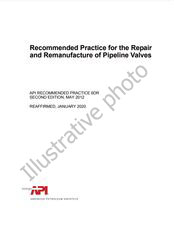We need your consent to use the individual data so that you can see information about your interests, among other things. Click "OK" to give your consent.

API PUBL 4734-ed.2005
Modeling Study of Produced Water Release Scenarios
Translate name
STANDARD published on 1.1.2005
The information about the standard:
Designation standards: API PUBL 4734-ed.2005
Publication date standards: 1.1.2005
SKU: NS-1139883
The number of pages: 146
Approximate weight : 469 g (1.03 lbs)
Country: American technical standard
Category: Technical standards API
Annotation of standard text API PUBL 4734-ed.2005 :
API PUBL 4734, 2005 Edition, January 2005 - Modeling Study of Produced Water Release Scenarios
A series of simulation experiments were conducted to evaluate how different produced water release and environmental characteristics (model inputs or factors) affect the fate of chloride in the subsurface (model outputs or responses). Model inputs include the hydrological and geological characteristics of the vadose zone and of the aquifer, climate, and characteristics of the release. A total of 11 factors were identified:
- 1. Texture of the vadose zone (e.g. sand, clay, etc.),
- 2. Depth to ground water,
- 3. Natural water content in the vadose zone,
- 4. Dispersion length of chloride in the vadose zone,
- 5. Climate,
- 6. Chloride concentration of the produced water release,
- 7. Volume of the produced water release,
- 8. Initial depth of produced water on the land surface (e.g., ponded within a berm or dispersed over a large area),
- 9. Ground water flux of the aquifer,
- 10. Background chloride content in the aquifer, and
- 11. Saturated thickness of the aquifer.
Model outputs from HYDRUS-1D are:
- • The maximum chloride concentration entering the aquifer from the vadose zone, and
- • The arrival time of the maximum chloride concentration at the aquifer.
Model outputs from the groundwater mixing model are:
- • The maximum chloride concentration measured at a monitoring well at the down gradient edge of the surface produced water release, and
- • The arrival time of the maximum chloride concentration at a monitoring well at the down gradient edge of the surface produced water release.
We recommend:
Technical standards updating
Do you want to make sure you use only the valid technical standards?
We can offer you a solution which will provide you a monthly overview concerning the updating of standards which you use.
Would you like to know more? Look at this page.



 Cookies
Cookies
